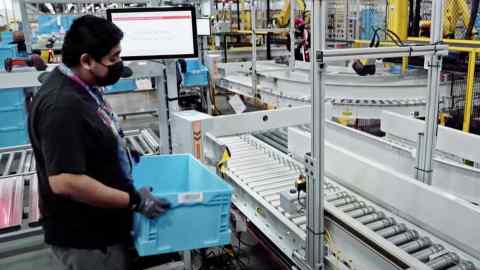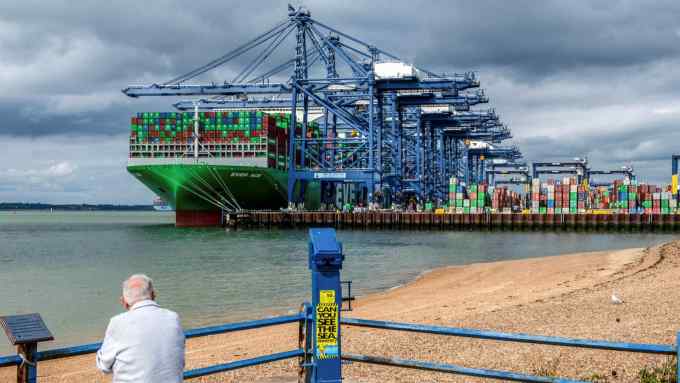
Vaccine distributors go the extra mile to help remote populations
 Shot in the arm: A Nepalese man receiving a Covid-19 vaccine © AFP via Getty Images
Shot in the arm: A Nepalese man receiving a Covid-19 vaccine © AFP via Getty Images We’ll send you a myFT Daily Digest email rounding up the latest Supply chains news every morning.
What do mules, yaks, 4x4s, walkers, motorcycles, banana boats and drones have in common? They are all used to deliver Covid-19 vaccines to hard-to-reach areas across the globe.
After devastating floods hit western Nepal in October, Budhi Setiawan, Unicef’s health chief in the country, had to come up with a solution to get Covid-19 shots into patients’ arms quickly.
The floods cut “a lot of access road”, and the shots needed to be airlifted, posing a “huge logistical challenge,” he says. The solution ended up involving yaks, mules, and transporting on foot, even though it could take them days to reach the area.
The efforts to get shots to hard-to-reach areas are part of the problem that much of the world faces in delivering life-saving vaccines to populations who often have not received their first shot. And, while the underlying lack of vaccine supply for much of the world is challenging in its own right, the logistics of the process can prove just as thorny.
Recommended Special ReportFuture of LogisticsLogisticians grapple to map out ‘cold chain’ for vaccine campaign
Setiawan says much smaller vehicles also had to be used to deploy the shots, with smaller vaccine carriers on top, though Nepal had very “good experience with these issues” and an extensive network of highly committed health workers.
Last year, global health observers were mainly worried about countries’ ability to develop the appropriate “cold chain” of refrigeration facilities to ensure vaccines remained viable after delivery.
But in Nepal, the opposite may be the issue, says Setiawan: vaccines currently used in the country, mostly from China, should be kept at conventional fridge temperatures. In freezing conditions, the challenge is to keep them from becoming too cold. He says Unicef had deployed freeze-preventing carriers just for that.
Still, an underlying lack of shots is holding back vaccination rates, not just in Nepal. For comparison, the landlocked country will begin to use the BioNTech/Pfizer shot on November 14, while the EU, the UK, the US and other richer regions in the world started administering it last December. About 25 per cent of its population have received two doses of any vaccine, and about 30 per cent one.
Recommended Special ReportFuture of LogisticsCovid turbulence still strain overextended supply chains2 hours ago
In poor countries, less than 2.5 per cent have received two shots — while in richer nations, that proportion comfortably exceeds three quarters of the population. Rich nations have, in three months, given more booster shots than poor countries have given primary doses — in all of 2021. Some observers call the divide “vaccine apartheid”.
To aid delivery to areas that are hard to reach, Setiawan says Unicef is also discussing using drones, which are already used in the Pacific region. However, the average altitude of Nepal terrain complicates matters significantly.
Security considerations — at the border with China, for example — must also be taken into account.
Still, he argues that Nepal’s previous successes with routine vaccination have helped to prepare the way for progress this time round. “If we were given supply, then we could have done better and reached the target for coverage of population faster,” he says.
Recommended Special ReportFuture of LogisticsRobotics supply helping hand to speedy order fulfilment2 hours ago
The most difficult challenge has been that demand had surged simultaneously for parts of the cold chain, creating bottlenecks in supply and complicating logistics even further. He notes that Nepal’s dependence on India for trade was also a significant stumbling block on the vaccine rollout at the height of the Delta surge earlier this year.
But it is not just geography complicating the rollout of vaccines. Benjamin Schreiber, Unicef’s global co-ordinator for Covax, the vaccine access programme, says Haiti and Papua New Guinea are extreme examples of violence and mistrust complicating matters significantly beyond simple logistics.
“People have to take banana boats to get to remote islands, and people are really dedicated to do this,” he says.
But in Haiti, Schreiber explains, six drivers were abducted as they planned to go out to deliver vaccines. “There’s carjacking, kidnapping, real fears for the drivers,” he says.
There’s carjacking, kidnapping, real fears for the drivers
Benjamin SchreiberIn Papua New Guinea, a healthcare worker setting up a vaccination site was verbally harassed and then pelted with stones. Some other workers, deployed to deliver routine childhood immunisations, were also stoned because the villagers thought they were bringing Covid vaccines. Another vaccination tent was torched, he says. In the country, a vaccine outreach trip can take three to four days, Schreiber says.
“There’s a lot of community engagement issues that need to be addressed . . . This goes beyond hesitancy,” he says. “We cannot just assume that people are going to show up and get the vaccines. People want to be informed, engaged — we have some tools in place to address these issues, but it will take time.”
Earlier investment a year ago would have smoothed out some of these problems and ensured there were enough healthcare workers in complex settings, he argues. “In some of these fragile settings . . . we need to really invest even more,” Schreiber says. “And that’s something that we really need to work together on to support the rollout.”
{"focus":["59d55e5c-cb83-49dc-bacb-26dcc51566d0","06610896-2754-4847-a48f-9363d18a8c5e","48256173-6393-4d0e-9364-19a52aef5df1","176b1156-b0a4-3ea1-9f39-5eff7ccbf1dc","fc708e00-51cc-48d4-9ce4-737761e18abe","ec4ffdac-4f55-4b7a-b529-7d1e3e9f150c","82645c31-4426-4ef5-99c9-9df6e0940c00","383edfe7-9e50-4aed-b22d-aa7da35e9441","8862bb0b-9e98-4e46-a3c0-7a0837f631ee","87e110e6-2170-408b-b267-d3b6bdbfeaa3","29e67a92-a3b8-410c-9139-15abe9b47e12"],"authorConcepts":["608ae840-75b7-4af7-b9e7-773beb07d0f8"],"displayConcept":"59d55e5c-cb83-49dc-bacb-26dcc51566d0"}Get alerts on Supply chains when a new story is published
Get alertsCopyright The Financial Times Limited 2021. All rights reserved.Reuse this content (opens in new window) CommentsJump to comments sectionPromoted ContentExplore the Special ReportREAD MOREFuture of LogisticsPort operators order ‘full steam ahead’ for supersized ships2 hours ago
- Currently reading:Vaccine distributors go the extra mile to help remote populations
- Robotics supply helping hand to speedy order fulfilment
- Port operators order ‘full steam ahead’ for supersized ships
- Distribution groups grapple to reduce their carbon footprints
- Euston trial shows appeal of letting the train take the strain
- Florist peddles pedals for flower power to tackle congestion
- Long hours and stagnant pay create transport bottlenecks
- Supply chains Add to myFT
- Health Add to myFT
- Covid-19 vaccines Add to myFT
- Nepal Add to myFT
- Donato Paolo Mancini Add to myFT
Owl Media Group takes pride in providing social-first platforms which equally benefit and facilitate engagement between businesses and consumers and creating much-needed balance to make conducting business, easier, safer, faster and better. The vision behind every platform in the Owl Media suite is to make lives better and foster a healthy environment in which parties can conduct business efficiently. Facilitating free and fair business relationships is crucial for any thriving economy and Owl Media bridges the gap and open doors for transparent and successful transacting. No advertising funds influence the functionality of our media platforms because we value authenticity and never compromise on quality no matter how lucrative the offers from advertisers may seem.
Originally posted on: https://www.ft.com/content/67907106-c8b7-4221-8b5d-3ed1d299e423